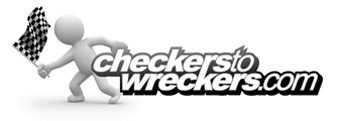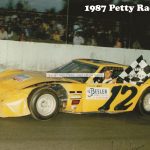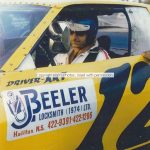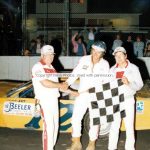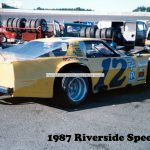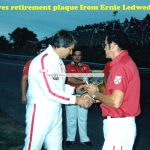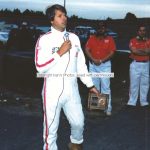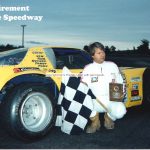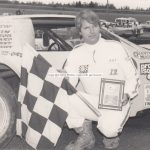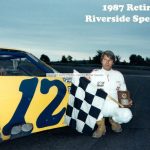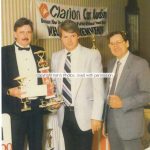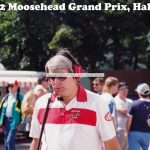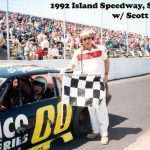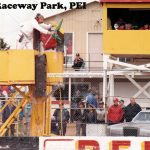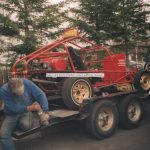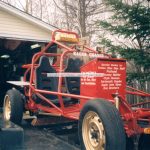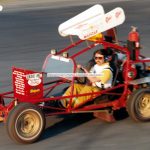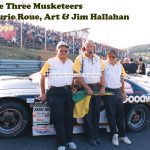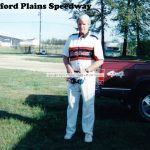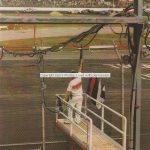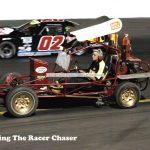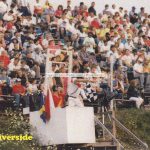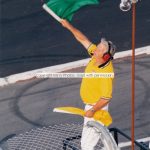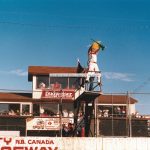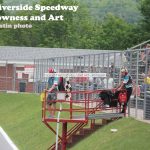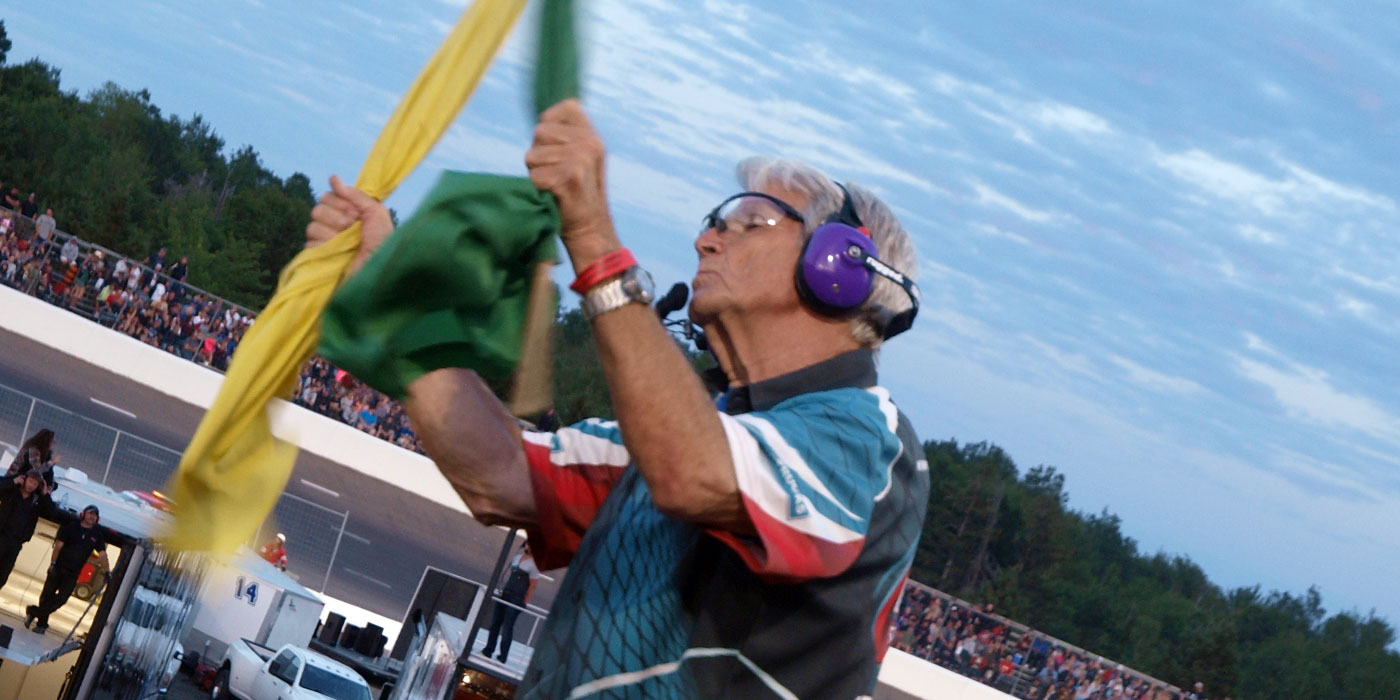From the editor: Ken MacIsaac’s (KM) popular ‘KenZone’ series continues with Art Steeves, popular longtime flagman of the Parts for Trucks Pro Stock Tour. What many may not realize is that Art’s career on the starter’s stand started long before the inception of the Pro Stock Tour and that his career in racing started long before he became a flagman. He’s been a force in Maritime stock car racing circles for over six decades and is still going strong with his distinctive style on the flagstand often mesmerizing fans who watch him as much as the action on the track. Steeves’ accomplishments in and contribution to stock car racing were formally acknowledged in 2014 when he was inducted into the Maritime Motorsports Hall of Fame. Many thanks to Ken MacIsaac for this story and all that great photos that accompany it as we profile Art Steeves.
KM – Before we start talking about racing, I always wondered why you settled in Pictou County?
AS – I grew up on St. Margaret’s Bay Road outside of Halifax, but lived in Timberlea for years. But my mom and dad were born in Pictou County. Dad worked at the radio station in Halifax. So I always loved coming down this way when I was young. So we moved here.
KM – When you were a young fellow, you got involved in demolition derbies before stock cars?
AS – That’s right. But if we go way back to when I was just a little guy, we used to race soapbox derby cars on a hill near the ferry in Pictou. I guess that would be my first introduction to racing. That would be around 1955.
KM – But you first hooked up with Clyde Hemeon on the demolition derby cars?
AS – Clyde ran a Texaco station in Timberlea, and I was there all the time. People from McEwen’s Raceway in Moncton came down and wanted to put on a demolition derby at the horse track in Lower Sackville. That would’ve been around 1963 or so. We had an old ’59 Plymouth that we pulled out of the woods. Clyde, the late Jack Dowell, and I geared it up. It was our first venture into car racing. The rules stated you had to have the gas tank in the trunk, which we did. However, Clyde installed a 5 gallon can inside the car, where the back seat would be. And that was our gas tank. The original tank in the trunk was filled with water. And this was all within the rules. Well, I got hit in the rear and it punctured the tank. Everyone thought it was gasoline pouring out so they back flagged me. We finished second in the derby and I almost won it, had they not black flagged me.
KM – You raced on the ice back then too?
AS – We raced Volkswagen buggies. That was in the mid 60’s. We used to take sections out of them, and run them on the ice in Timberlea. Gary Jollimore and I took 18 inches out of them. Then we’d take 24 inches out. Then take 32 inches out. But you couldn’t keep the front end on the ground. We’d put lead in the front where the spare tire would normally be. That helped to keep it on the ground. That was a lot of fun.
KM – So after all that, you built a Hobby car for Seabreeze Raceway?
AS – Yes, but I ran another demo derby at Seabreeze. We had a ’58 Oldsmobile. But you had to qualify for the derby first. You had to go around the track and drive up a ramp on your left side, then do it again on your right side. We knew they were going to make the cars do this before we got to the track. So we took hardwood logs and inserted them into the coil springs. It made the car stiffer and more rugged. Anyway, if you survived the two ramps, then you had to go over another ramp on all 4 wheels. So we did all that. But when I landed, the impact drove the motor up and split the distributor cap. We couldn’t run the derby unless we had a distributor cap. We called over the P.A. to see if someone in the grandstands had an Oldsmobile to see if we could borrow their distributor cap to keep going. Sure enough, someone did have one and lent it to us. And we ran the derby that day.
KM – Then you built a stock car?
AS – At the end of the 1967 race season, I bought Jim Weeks’ ’37 Chev. It was quite a car. I had it all prepared for the ’68 season at Seabreeze, but the track decided to put pavement down. Well, I didn’ t want to run that car on asphalt, so I sold it to the Murphys in Eastern Passage. Then Clyde and I bought a ’57 Chev to race. There was 2 of us driving the car. Myself and another guy. Clyde was the mechanic. We were up to second in points with one week left in the season. The second last week of racing, I flipped and ended up on my roof. It happened on the last lap of the feature too. The car was junk. We were up to second place in points too. Anyway, we asked the officials if we came back next week with an identical car, could we keep our points.
KM – Did you have to run the whole season with the same car?
AS – Yes. You had to run the same car all year. So the officials said “no problem”. But it had to be another ’57 Chev. So we looked all week for another ‘ 57. Could not find one. We did find a ‘56 Chev which was close. So we cut the roof off our ’57, cut the cage out and welded it into the ’56. We put the front clip off the ‘57 on it and painted it blue. We had it looking almost identical to the ’57 Chev. We didn’t have the fins on the quarter panels like the ’57 had, but they still let us run. We painted it at a military shop on Cobequid Road. I remember the paint was still wet when we got to the track that day. Scotia Chevrolet in Halifax heard about all the trouble we were having after the flip and came aboard that week as a sponsor. They gave us a camshaft and lifters out of a Z-28.
KM – Did you continue running that car?
AS – I’m not sure what happened to that car? I think Bobby Yuille ran it for Clyde after that.
KM – So tell me about Drag City?
AS – I bought John Howard’s car in 1970. It was a ’55 Chev. Clyde and I ran that in the Sportsman class. They had a year-end International race and I was running in the top 5. About 10 laps from the end, I was up to 3rd place. I knew the car wouldn’t do any better unless someone had a flat tire or broke. I knew I wasn’t going to catch the top 2, so I was content running in the top 5. One car pulled down in front of me while we were lapping him. I always said that I’d never hit a fellow in the driver’s side door. So I swung down low to miss him and I hit a huge rock in the infield. The car went end over end twice and back out onto the track again. I was on my roof, driver’s side facing the oncoming traffic. Another car hit me. His bumperette actually hit me in the helmet. It split my helmet in two. I was shaken up. I remember getting out of the car in pain and telling the tow truck operator to pick the car up from the front, so it could be loaded on the trailer backward. I had enough sense to know that since the car had so much damage, it would be easier unloading it at home that way. When I got to the pits, they told me that I better go to the hospital to get checked out. This all happened on a Saturday night by the way. I was pretty sore and in a lot of pain, so I agreed to go. They told me at the hospital I had really bad whiplash, and I had to stay in over the weekend. They told me, “on Monday morning, we’ll get you up and around, and you should be able to go home.” But on Monday morning when they tried to get me up, I’d pass out. So they sent me down for more x-rays. That put me in every position my body could go in. The doctor came back and said, “you have a severed cord in your neck”. I couldn’t believe I broke my neck in that wreck. So I ended up going home in a body cast.
KM – Thankfully people at the track knew something wasn’t right and made you go to the hospital.
AS – Yes. I remember Bob Brooks, who was running the track, ran from the tower to my wreck. He jumped in the car and cut my belts to get me out. He broke his arm while doing it. He slammed his arm into the roll bar trying to get to me. He was afraid my car would burst into flames. Funny how I remember that plain as day. But there were a lot of drivers who came to visit me in the hospital back then. It meant a lot.
KM – Tell me about your recovery?
AS – The wreck happened the first week of September. I wanted to go back to work. I mean, if I didn’t have an income, I’d lose my house. When we raced at Drag City, we paid $1.00 per week for insurance. That was thanks to Bob Brooks. So Bob set it up that I was getting 50 bucks a week from the track’s insurance policy. I thought that was great. So I was still on salary at the TV station too. I couldn’t do a whole lot, being in the body cast, but I had to do something. So I ended up working the master controls during the dinner breaks. It wasn’t full-time work, but it kept me busy and I was getting paid. So I did that for a bit until I started to heal. But the insurance company found about that $50.00 per week, and they stripped me of it.
KM – But eventually you did get better and got back to work full time. You even went back to the track?
AS – I did. I couldn’t stay away from the sport. In 1972 I was teching at Riverside. Actually, Clyde did some teching too. I flagged a lot of local tracks in the 70’s. I wanted to stay involved somehow.
KM – And you even got back behind the wheel?
AS – I was out of the race car for a number of years. I missed it. I went back against doctor’s orders. My dad made me promise him, “if I went back racing I’d never have another orange race car.”. That was the color of my ’55 Chev that I broke my neck in. So I kept that promise. I bought Skip MacKenzie’s Dairy Queen car. It was a good car. Blair Crooks and Mike MacKenzie built it. I even kept Skip’s number.
KM – You ran that car at Atlantic Speedway?
AS – 1980. Ran Atlantic and Onslow. We used to race Sunday afternoons at Onslow. Once the racing was done, we’d quickly load up and head to Atlantic Speedway. They ran on Sunday nights. At the start of the season, Jim Corbett, who was running Atlantic, told us all upfront that it would save us money if we ran slicks there. At Onslow, we ran treaded tires. So we agreed and bought rims and slicks for the year. Well, it didn’t work out that way. It ended up costing us more.
KM – Did you like running at Atlantic Speedway?
AS – I always thought it was ahead of its time. Beautiful track and super fast. We’d leave Onslow and get to the track in the evening, and sometimes it was so foggy on the backstretch, you couldn’t see the car in front of you. I know the fans in the grandstands couldn’t see us on the backstretch. I remember following Terry Clattenburg and just barely making out his car in the fog. When Jim Corbett built the track, he put 5-gallon cans all around the outside of the track and filled them with concrete. Then he put a piece of railway in the wet cement. Once it cured, the guardrail was fastened to that. But after several years of heavy rains, it softened the earth around the guard rails. I remember Blair Crooks hitting the wall one time and the guard rails letting go because of the erosion. But I enjoyed racing there, but I was always extra cautious and noticed things like that.
KM – Onslow is where I have the most memories of you racing.
AS – Good times there. The sportsman class we had was one of the best around. Great guys. Great racing. We all got along pretty well. I’ll tell you a story. George Koszkulics blew the radiator in his truck while towing his stock car to Onslow. He was broke down on the Trans Canada highway near Salt Springs. So I stopped my truck and trailer and said: “let’s tow you to the track”. I’ll hook onto your truck and trailer and just tow you. It was sluggish but we made it. When we pulled into the pits, I could hear the announcer Scott Matthews say “Now there’s true sportsmanship folks, Art Steeves towing a fellow competitor”. They all made a big deal about it, but it’s just what you did back then.
KM – I remember when you came to Sydney with your Sportsman. That was in 1981.
AS – That was an Invitational. A few of us guys came down. I’ll tell you two quick stories about the Sydney track. When Mascar came to town, the start time for the race was always 7 PM. But one of the first times we went there, it was around 6:50 PM, and there was hardly anyone in the stands. We were starting to worry. But at 7 PM sharp, the fans were lined up at the ticket booth. I think everyone was relieved. But that’s the way it was there. At another Mascar race, the staff came to me and asked: “what can we do for you Art?”. They were very accommodating, very easy to deal with. The Dicks family I believe. Anyway, I remember the walls were all steel, like boilerplate. I used to go down onto the track to give the checkered flag to the driver. But it was quite a drop from the top of the wall to the pavement. So I suggested to the staff that they cut toe clips into the wall. It would make it easier for me to get down onto the track. And they did. Right away. Never forgot that.
KM – A lot of the Onslow Sportsman guys were running with Mascar back in the day?
AS – When Mascar started, they were always short on cars. A lot of us Sportsman guys would run their shows since there really wasn’t a whole lot of changes to our cars. I remember changing rear end gears. And you had to run their treaded tires. I’m sure there were other things, but those stand out.
KM – When you started racing Mascar fulltime, did you still have the Skip MacKenzie car?
AS – No. I sold that and had one of Greg Sewart’s cars after that. I think that’s the car I ran with Mascar. I also built another Sportsman during that time. Doug Roberts had an old cage and frame that was in the woods near his home. I hauled it out and brought it home. I turned it into a sportsman in my yard. Didn’t even have my garage built at the time.
KM – You had a dedicated crew back then too?
AS – Just a great group of guys. Al Hill from Halifax just “ate and slept” racecars. It was his life. Ernie Wright from Moncton. Ernie was with me until I gave up driving. I’d come in the pits under caution and Ernie would check all 4 wheels, check for leaks, and hand me a drink, all in one motion. Chris Burgess and his brother Steve. They were longtime friends. The Bayer brothers. Their father Don had a service station next to the TV station. His 2 sons helped me. My brother Robert came with me a lot too. And I have to mention my daughter Carol. She grew up around race cars and was always with me in the garage. I remember working in the cold garage in the offseason, and Carol there with me. She loved it too.
KM – You had a role in the paving of Oyster Bed Speedway, didn’t you?
AS – They wanted us (Mascar) to go over and put on a demonstration. That was in 1987 I believe. Ron Hughes was running the track at the time, and he asked us if we could bring a few guys over and put on a show, a demonstration. He said he had quite a few interested parties who would like to see the track paved. He said it was time for a change. So Rollie, Terry Clattenburg, Bobby Yuille and myself went over and put on a display. We had a little race on the clay. The cars were kicking out in the turns but we all ran dirt before so it was no big deal. They really treated us well that day. They even had firetrucks there to wash down our cars before we left. Anyway, people in the stands were impressed. So Ron Hughes said, “we’ll do it and pave the track”. So we all went home happy with our demonstration. Early the following week, Ron called Jim Hallahan and said “I see you have one or two open dates on your schedule. Is there a way you can fit us in?” Ron said, “I guarantee you that whatever date you give us, the track will be paved”. So Jim gave him a date, and sure enough, the track was paved when we got there. But you know what? The 4 of us weren’t very well received by a lot of the locals when we got there. A lot of the die-hard dirt track guys figured we were the ones who changed the racing from dirt to pavement. We even offered to help set up their cars and do anything we can. We said, “it’s the way of the future”. Most guys were happy to run on pavement, but a lot weren’t interested. Alan and Kent Vincent were ones that stand out as accepting the pavement. They were all for it and appreciated our help. We were spoiled with asphalt racing. We’d been running on it for so long. So it took a while for the dirt racers to accept it. And a lot of guys didn’t. But looking back to when we went over in ’87 and comparing it to now, we have so many top quality racers from PEI running the tour now.
KM – I didn’t realize you did some road racing back then too?
AS – It was actually a rally. Ford Motor Company held a rally 3 years in a row. It was down by Peggy’s Cove. The 1st year, I had a brand new Ford Bronco II. I remember running all over icy roads that year and got a 3rd place finish. The 2nd year I finished 2nd. On the 3rd year, Scott Matthews (ATV sports announcer) was supposed to be my navigator. So we had to stop at these checkpoints along the race. At one of them, he said “I think I’m going to get sick” I said, “well, I’m not stopping”. And Scott got sick out the window. But I won that rally. After the race, the Ford reps came over and were wondering how I did it so quickly. They said I was 25 minutes faster than previous winners.
KM – Back to Mascar. I remember when you officially retired from driving.
AS – That was at Riverside in 1987. Ernie Ledwedge got me a nice plaque. I had previously announced that I was retiring from driving. It was a nice presentation. It meant a lot to me.
KM – Remember the Moosehead Grand Prix? Had you retired from driving by then?
AS – I had, but I was Race Director/Event Coordinator for the Mascar Tour at the Grand Prix. On practice day, we had 32 cars show up. We lost one on the day of the race, but we started 31 cars that day. What a show we put on in downtown Halifax. The Indy car people couldn’t get over all the rubbing and passing our guys were doing. I think they only brought 14 cars and only 7 finished. I felt like we definitely were the highlight of the weekend.
KM – You had several cars in the 80’s. Do you remember where they all ended up?
AS – I can tell you that 3 of my cars ended up in PEI. My last Mascar went to Belmont Nickerson. Lionel Hemlow got one of my cars, so did Dale Richardson. The Doug Roberts car was sold to a great big guy who worked at Walter Piccott Chev-Olds in PEI. Can’t remember his name.
KM – Did you ever drive a race car after you retired?
AS – One time at Shediac, Dale Richardson said to me “you’ve got more laps in a race car than I have, why don’t you take it out in practice”. So I did. I came in and said “you guys are spoiled with power steering. When I used to run we didn’t have any”. That was it. But you know what? I felt comfortable in it.
KM – I want to switch from racing for a minute, and talk about Christmas Daddies. You’ve been involved in that all your life.
AS – 54 years. I got hired at the TV station in August of 1964. I was hired as a shipper/film helper, eventually editing supervisor. So Jim Hill Sr. and Jack Dalton worked at the station. They met at the Derby Tavern one day. A little boy walked in the tavern when they were there. He was poor. He started circling the room begging for money. The staff there eventually told him to leave. So Jim and Jack felt bad about it, and they raised money for him and his family, just by passing a hat around the bar. But after that, Jim said, “it’s time we did something for all the kids”. I was young starting out at the station and didn’t know a lot. But I knew something was going to happen with the telethon. Originally, the airtime was given at midnight. That’s when we went on. And I’ve volunteered at every one of them.
KM – You must’ve seen some amazing talents perform over the years?
AS – Incredible. One that stands out from the early years was a children’s choir. There were 52 kids. We had one fairly large studio and another small one where we did commercials. So anyway, the parents of the kids wanted to come. So now we more than doubled the people in the studio. And then the grandparents wanted to come. That stands out to this day. You could hardly move in the building. I also remember how excited we were to move from black and white cameras to color ones.
KM – Was the telethon always held at the TV station?
AS – No. In the early days, we thought we had graduated by leaving the studio and moving it to local schools. We had more volunteers back then too. But all the gear had to be lugged into cube vans and taken to the QEH high school or St. Patrick’s high school. We had to set up the lights and cables and 9 times out of 10, mother nature said: “while they’re setting up, I think we’ll have a storm”. It never failed. Either on the way to set up or on the way to take down the gear, we’d have a huge storm. And we had to get it all put away and ready for Monday morning’s show too. This happened year in and year out. Then we went to the Rebecca Cohn for several years. That worked out pretty good. The storms didn’t seem as bad during those years. Maybe we were just used to them. But we always did well on the telethon, because the weather was usually bad and people stayed home and watched.
KM – I have to ask you why they switched the telethon from Sunday to Saturday?
AS – Everybody asks me that. And everybody I talk to preferred Sunday. The main reason is that NFL football is on Sunday, and that’s a big day for commercial revenue.
KM – So back to racing. After you retired from driving, you turned to ‘flagging’ full time?
AS – I didn’t want to walk away from the sport. I wanted to stay involved somehow. I felt I was articulate on the flag stand. Figured I could do a good job. I saw ‘Silent Sam’ (a mechanical battery operated flag on the MacDonald Bridge in Halifax) get shot once and stolen twice. And nobody’s shot me yet. I always felt you have to have someone who’s going to put an effort into it. Fans come to me young and old and say “how do you see so much during a race?” In a feature, you pick stuff out and pass it along on the radio. It’s just experience. Knowing where to look, knowing when something’s about to happen.
KM – You’ve flagged at all the Maritime tracks and even some U.S. ones.
AS – One of the highlights for me was flagging the Oxford 250. I’d been going there since 1977, so to actually flag the 250 in 1998 was something else. I also did the Mascar tour at that time as well. So Oxford Plains Speedway was part of their schedule, along with Speedway 95 in Bangor, and White Mountain Speedway in New Hampshire. The year I flagged the 250, I ‘time trialed’ over 100 cars. It was so hot that weekend too. On the day of the race, I was on the starter’s stand at 6:45 AM. The local fire department came and did an interview with me. They asked me if I needed anything, and I just said: “a cold water or a cold coke under the flagstand would be great”. I told him “if you see me horizontal (from the heat), just hose me down and I’ll be fine.” Another time, I was flagging a Saturday race at Oxford. It was over at 8 PM. I jumped in my van after the race and drove straight back home. Drove non stop. Stopped at my house to shower and change clothes. Then took off to Riverside, where the Mascar race was starting at 2 PM. I flagged that race as well.
KM – I think it’s safe to say that you’re one of the most recognizable people in local racing.
AS – A lot of people say to me “you must be the longest living flagman around” or “you must’ve flagged the most stock cars of anyone”. Like I said, on weekends that we were off from the tour, I’d go and flag other tracks. I liked all the tracks. The only track I’d get nervous at was Exhibition Park. They had jersey barriers around the track, and I was always afraid a car might jump it. But then again, that’s me being extra cautious.
KM – You’ve flagged NASCAR stars and local racing legends. I want to run some random names by you. I know you have interesting stories of just about everyone, so tell me about Junior Hanley?
AS – Clyde and I used to go up to his shop in Spryfield all the time. He and Clyde were good friends. But I remember when he moved to Ontario and was winning a lot. Businesses would go to his shop and give him promotional products, such as motor oil or filters. They were trying to get him to use them so they could get their name on his car. Anyway, they’d come back a week later and say “how did you find that Junior? Did it help?” Hanley would say “Oh ya. It took a 10th off my lap time”. Meanwhile, it would still be in the box in the corner
KM – Tell me about Clyde (Hemeon)?
AS – Clyde was my mentor. I got hooked on the sport because of Clyde. He really enjoyed racing. Look at who drove for him? The Sewart’s, Charlie Kane, Bobby Yuille, and of course his own son Blair. Clyde would come to my garage and my dad would be there. Clyde would say “Hello Mr. Steeves”. Dad would say, “just call me Burt”. And now I get that from a lot of people. And I just say “No, Mr. Steeves was my dad”.
KM – How about Don Biederman? I know you flagged him when he won the Riverside 250.
AS – The hardest hit I had in my life, other than when I broke my neck at Drag City, was from Biederman. He drove into the back of me at Onslow one time, and I’m sure he didn’t take his foot out of it at all. I remember we had a hard time pulling the frame after that hit.
KM – I love these stories by the way. Tell me about Frank Fraser?
AS – Known Frank for a long time. Always enjoyed his company. We ran together and he was always faster than me. Frank could make junk run good. I tried to get some ideas from him to make mine a little quicker. And there were times he’d open up to me, and other times he kept to himself. We chit chat to this day about the good times we had, and I like that. You know, we’re all part of this cog that makes this thing work. The older group won’t be around forever.
KM – Tell about Scott (Fraser)?
AS – A tremendous talent. So sad the way he went. To me, he was an engineer. He built a spiral staircase for a mansion in Newfoundland. I think they flew him over the first time and he took his measurements and everything. From what I remember, it fit like a glove when it was done. To me, that’s an engineer. I’m sure Frank could tell you more about that, but it stands out in my mind. The talent that lad had. Amazing.
KM – John Chisholm?
AS – Every race we go to at Riverside, I put a picture of his Mustang race car in the front window of my motorhome. Miss him dearly.
KM – You have to tell me about the Racer Chaser. It’s such an important part of local racing history.
AS – We used to go to New Smryna Speedway every year for Speed Weeks. One year, I saw something like it at the track. They had 2 of them. I spoke to the track and they let me in their shop during the day. I told them who I was and what I wanted to do. My brother took a bunch of pictures of it so I could get ideas from it. To me, I thought it would be an asset to have back home. I heard rumours that someone in Ontario had started to build a cage that looked similar to it. As it turned out, that cage arrived at a used car dealer in Sackville. It was just the cage, nothing else. Anyway, when I went to see it at the used car lot I told him what I wanted to do with it. The owner said “I’ll even sponsor you a bit” So I took the cage home and started from the ground up. I put a front end under it from a VW. Put a transmission in it. I got a lot of parts from the folks at Settles Volkswagen out in Harrietsfield. That was thanks to John Flemming who knew them well. Forbes Chev-Olds painted it for me. Chris Sullivan down in Yarmouth helped me out too. Tommy and Sharon O’Hearn ran Merle Norman Cosmetics, and every year they’d give me money too. Anyway, I took 4 of the coarse bristle brooms and bolted them to a 3-inch channel. I hooked it to the emergency brake and that swept the track after the kitty litter went down. I installed a wing on it too. Cathy Ledwedge and my sister died around the same time, and I put a memorial on the wing to honor them.
KM – Where is it now?
AS – Speedway 660, and they’re still using it. I had it 19 years. The guy in Fredericton came to me this past summer and said: “the only thing we had to change, was the plywood under the seat.” I only sold it back then because I had prostate cancer. I had a lot of offers from guys wanting it for a dune buggy. But I really wanted it to go to a race track. Chris Burgess, who used to work on my race car back in the day, drove it most of the time. My brother drove it a few times too. And sometimes I’d drive it.
KM – You were also inducted into the Maritime Motorsports Hall Of Fame?
AS – Yes, in 2014. There was a group from PEI who nominated me. It was an overwhelming honour. I had quite a few emotional moments that night. I’ve been dedicated to the sport for so long. It was a very special deal to me. It meant a lot. My whole family came to PEI for the induction.
KM – So I assume we’ll see you flagging again this summer?
AS – Jim Hallahan is one of my best friends. We keep saying to each other “when we go, we should go as a pair”. This past year, I was strongly thinking of packing it in. Jim said “come on, one more year,” I said, “we’ve been saying that for 6 or 7 years now”. This past year was going to be my last. So I guess I have to see how I’m feeling, and how the spring goes. My back kills me at times. If I’m able to keep going this year, I’d like to see if I can sit down and rest more. I flag all the practice and heats, so maybe if I can just do the features, and have Rob (Bowness) do the heats and practice. That may be a little better on my back. We’ll see.
KM – Always enjoy our chats, and hope to see you at the track.
AS – Thank you, sir.
(click image to enlarge photos)
Photos available from Ken MacIsaac (kensphotos@ns.sympatico.ca)
